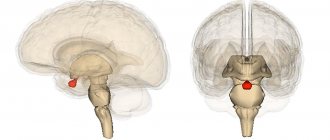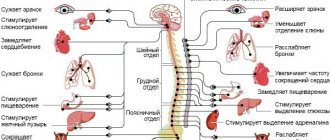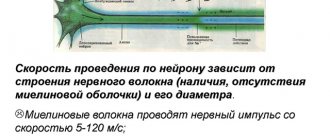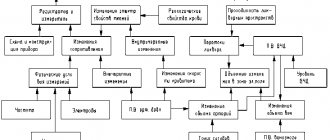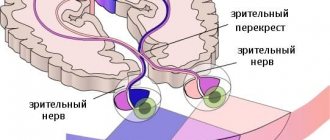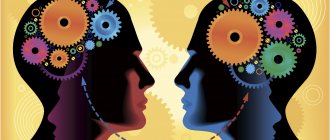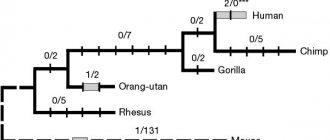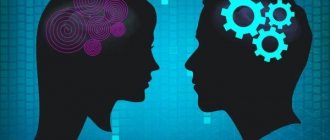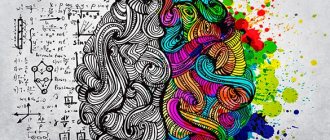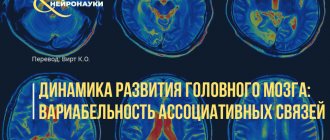"Split Brain"
The separation of the hemispheres doubles consciousness. Sperry said: “In other words, each hemisphere seems to have its own independent and private sensations, its own perceptions, its own concepts, and its own motivating impulses.”
How does a split-brain person function after surgery?
Having two "brains" in one body can create a serious dilemma. When one split-brain patient got dressed, he would sometimes pull his trousers down with one hand and pull them up with the other. One day this patient grabbed his wife with his left hand and shook her violently. His right hand gallantly came to the woman's aid and intercepted his militant left hand. Although such conflicts can occur, it is much more common for split-brain patients to behave completely normally. The reason here is that both sides of the brain have almost the same experience at the same point in time. Moreover, if conflict arises, one half usually prevails over the other.
Split-brain effects are most easily observed during special tests. For example, we could flash a dollar symbol to the right side of the brain of a patient named Tom. And direct the image of the question mark to the left half of his brain. Next, Tom is asked to draw what he sees, using his left hand blindly. The left hand draws the dollar symbol. If Tom is then asked to point with his right hand to a picture of what his “invisible” left hand has drawn, he will point to the question mark. In short, in a split-brain person, one hemisphere may not know what is happening in the other. This is an extreme case of the situation when “the right hand does not rise, what is the left doing?
Topic 5. The problem of interhemispheric brain asymmetry and interhemispheric interaction
5.1. History of the study of functional brain asymmetry: clinical, physiological data.
5.2. The concept of left hemisphere dominance (in right-handed people).
5.3. Anatomical, physiological and clinical evidence of inequality between the left and right hemispheres of the brain.
5.4. The concept of functional specificity of the cerebral hemispheres.
5.5. Partial nature of functional asymmetry, motor and sensory asymmetries.
5.6. Differentiated nature of interhemispheric interaction.
5.7. Studies of the types of interhemispheric asymmetry are normal.
5.8. Lateral features of disorders of gnostic processes, voluntary movements and actions, mnestic intellectual processes, emotions.
5.9. Specificity of neuropsychological syndromes in left-handers.
The problem of interhemispheric asymmetry and interhemispheric interaction is one of the most pressing problems in natural science. The first evidence of lateralization of functions dates back to the school of Hippocrates, when connections between unilateral head injuries and contralateral convulsions were observed and described. By the beginning of the 19th century. Quite a lot of evidence has accumulated about the disparity between the left and right hemispheres of the brain. Anatomical data obtained at the Brain Institute of the Academy of Medical Sciences, as well as the results of foreign authors, indicate that already in some animals (rats, cats, monkeys) the length of the Sylvian fissure in the left hemisphere is greater than in the right. In humans, these differences are more pronounced. Thus, Wernicke's area (the upper sections of the secondary zones of the temporal region) in the left hemisphere is one third larger than the zone of the right hemisphere that is symmetrical to it, the neurons of the left hemisphere (in right-handed people) are larger than the neurons of the right hemisphere, and even the diameter of the blood vessels in the left hemisphere is larger than in the right. There is information about differences in the organization of the left and right thalamus, the left and right caudate nucleus in those thalamic nuclei that are associated with speech.
Physiological data are even more convincing: when evoked potentials are recorded, they are first noted in the right hemisphere, and then gradually cover the left. It is believed that this is due to different ways of processing information (the right one processes it holistically and simultaneously, and the left one does it analytically and sequentially). It has been proven that the left hemisphere is activated when performing some tasks, and the right hemisphere others. Using the method of evoked potentials arising from the sounds of human speech in newborns, data was obtained that in nine out of ten children the amplitude of the reaction in the left hemisphere is noticeably greater than in the right, and for non-speech sounds (noise or musical chords) - in all In ten infants, the amplitude of evoked potentials is higher in the right hemisphere. All this convincingly indicates that left-right asymmetry is characteristic of the norm and is especially clearly manifested in conditions of mental activity.
Clinical observations confirm the obtained facts: speech disorders occur predominantly with damage to the left hemisphere, while damage to the right hemisphere leads to the appearance of a unique symptom complex, including a violation of the body diagram, loss of the visual field, disturbance of spatial orientation, etc.
All these data (anatomical, physiological, clinical) convincingly indicate the inequality of the structures and functions of the left and right hemispheres.
E.D. Chomsky, studying the history of functional asymmetry of the brain, argues that this theory has gone through several stages in its development. The first classical concept of functional asymmetry was based on the position of the absolute opposition of the functions of the right and left hemispheres. It was believed that the left hemisphere was completely dominant in speech and all mental processes, and the right hemisphere was assigned a subordinate role in the organization of mental activity. Moreover, according to J.H. Jackson, dominance itself was understood as the leading role of the left hemisphere.
By the middle of the 19th century. Research interest has shifted from studying the left hemisphere of the brain to the right. The theory of functional asymmetry, supported by new data, is called the “relative dominance concept.” It was still based on the idea of the opposition of the functions of the left and right hemispheres and affirmed the idea of the relative dominance of the left hemisphere in relation to speech functions, as well as mental processes mediated by speech (in right-handers) and the relative dominance of the right hemisphere in the organization of non-verbal gnostic functions. This approach is characterized by the idea of global asymmetry, which suggests a relationship between greater activity in one hemisphere and dominance of the contralateral arm, leg, eye, etc.
Currently, the problem of interhemispheric asymmetries is considered as a problem of the functional specificity of the hemispheres, as a problem of the uniqueness of the contribution that each hemisphere makes to the organization of any mental function. Both the left and right hemispheres take part in this, but each makes its own specific contribution. Functional asymmetry refers to the participation of the left or right hemisphere of the brain in the implementation of mental functions that is different in nature and unequal in importance. This approach is characterized by the following provisions:
– functional asymmetry is not global, but partial. There are motor asymmetries (manual, leg, oral, oculomotor, etc.), sensory (visual, auditory, tactile) and mental (asymmetry in the organization of speech and other mental functions). In different systems, the nature of functional asymmetry may be different;
– Each specific form of functional asymmetry differs in its degree and degree of severity. We can talk about strong or weak asymmetry;
– functional asymmetry of the cerebral hemispheres in an adult is a product of the action of biosocial structures. As studies conducted on children have shown, the foundations of functional specialization are innate, but as the child develops, the mechanisms of interhemispheric asymmetry and interhemispheric interaction improve and become more complex.
The second aspect of the problem of interhemispheric asymmetry, no less important, but less studied , is the issue of interhemispheric interaction. For a long time it was believed that both hemispheres of the brain are absolutely independent and represent the same paired organ as the kidneys or lungs. But Roger Walcott Sperry's work on cutting the commissures of the brain showed that when the relationship between the left and right hemispheres is disrupted, serious disturbances in mental functions occur. The result of transection of the commissures of the brain (corpus callosum), called the “Split Brain Model”, is characterized by a triad of symptoms:
– anomia, which manifests itself in a violation of the ability to report on all types of sensory information entering the right hemisphere;
– discopia-dysgraphia, which is characterized by impairment of writing and constructive activities when performed with one (right or left) hand;
– impaired coordination of movements.
Experiments have shown that with partial transection of the corpus callosum, these symptoms do not fully appear. This is due to the fact that the corpus callosum is not a homogeneous organ, but is a differentiated system, different parts of which perform different functions in the mechanisms of interhemispheric interaction. With partial transection of individual sections of the corpus callosum, disturbances of only one modality occur. In addition, with partial transection of the corpus callosum, a relatively rapid restoration of mental functions is observed.
Work under the direction of E.G. Simernitskaya showed that the processes of interhemispheric interaction in children proceed differently than in adults. Split brain syndrome is not observed in children because the corpus callosum matures quite late (around age twenty).
The systemic nature of mental activity consists in the differentiated participation of various brain formations and hemispheres of the brain in the organization of higher mental functions. No one hemisphere can be considered dominant in relation to any function or activity. Each hemisphere dominates according to its inherent principle of operation, according to the contribution it makes to the organization of mental function. Thus, we can say that the interhemispheric organization of mental processes is based on the unity of two factors: the functional asymmetry (specialization) of the cerebral hemispheres and their interaction in human mental activity.
Basic terms and concepts:
discopia-dysgraphia, Wernicke's area, "relative dominance concept", lateralization of functions, left-right asymmetry, "split-brain model", corpus callosum, motor asymmetries (manual, leg, oral, oculomotor, etc.), impaired motor coordination , disparity of structures and functions of the left and right hemispheres, the problem of interhemispheric asymmetry and interhemispheric interaction, the problem of functional specificity of the hemispheres, mental asymmetries (asymmetry of the organization of speech and other mental functions), sensory asymmetries (visual, auditory, tactile), theory of functional asymmetry of the brain.
Questions and tasks for self-test
1. What is the manifestation of anatomical asymmetry of the brain?
2. How does functional asymmetry of the brain manifest itself?
3. Why are the functions of the right hemisphere less studied than the functions of the left hemisphere?
4. At what stage in the development of the theory of functional asymmetry of the brain are the ideas of mandatory retraining for left-handers typical?
5. What is the partial nature of interhemispheric asymmetry?
6. What are cerebral commissures?
7. What is “split brain syndrome”?
8. How is interhemispheric interaction different in children?
9. How does anomia manifest itself after partial transection of the corpus callosum?
10. Until what age does the formation of interhemispheric connections occur?
Subjects of abstracts
1. History of the study of functional brain asymmetry: clinical, physiological data.
2. The concept of dominance of the left hemisphere (in right-handed people).
3. Anatomical, physiological and clinical evidence of inequality between the left and right hemispheres of the brain.
4. The concept of functional specificity of the cerebral hemispheres.
5. Partial nature of functional asymmetry, motor and sensory asymmetries.
6. Differentiated nature of interhemispheric interaction.
7. Lateral features of disorders of gnostic processes.
8. Lateral features of disorders of voluntary movements and actions.
9. Lateral features of disorders of mnestic intellectual processes.
10. Lateral features of emotional disorders.
11. Specifics of neuropsychological syndromes in left-handers.
Difference between the left and right hemispheres of the brain
The functions of the brain are divided in a remarkable way. For example, approximately 95% of all adults use the left hemisphere for language (speaking, writing, and understanding). In addition, the left hemisphere has superiority in mathematics, timing and rhythm, and coordinating the order of complex movements such as those required for speech.
In contrast, the right hemisphere responds only to simple language and counting. Working with the right side of the brain is like talking to a child who only understands a dozen words. To answer questions, the right hemisphere must use nonverbal responses, such as pointing at objects.
Although the right side of the brain is weak in language, it has its own talents, especially perceptual skills. During the test, the right hemisphere is better at recognizing patterns, faces and melodies, solving design problems or drawing a picture. It is also involved in recognizing and expressing EMOTIONS.
